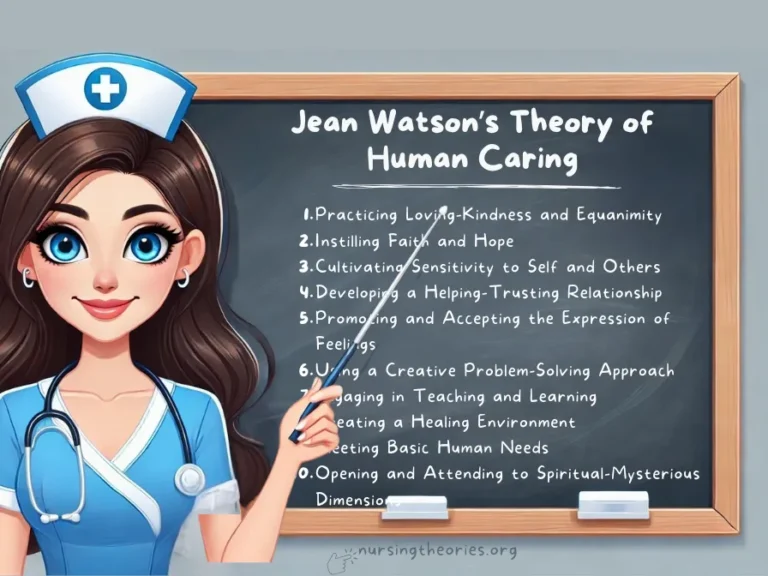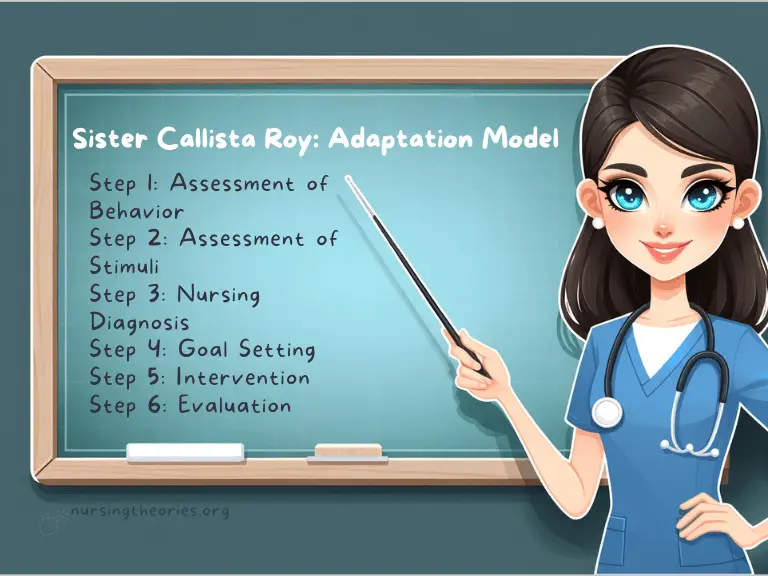Nursing theory is the backbone of the nursing profession, providing a structured way to understand, explain, and improve patient care.
For nursing students, mastering the basics of nursing theory is essential not only for exams but also for building a solid foundation in professional practice.
This guide breaks down nursing theory into easy-to-understand concepts, with practical examples, tables, and tips to help you connect theory to real-world nursing.
What You’ve Learned
- Nursing Theory is the foundation of nursing practice, guiding clinical decisions and enhancing professionalism.
- The Nursing Metaparadigm includes Person, Environment, Health, and Nursing, providing a holistic care framework.
- Types of Nursing Theories include Grand, Middle-Range, and Practice-Level, each serving unique purposes.
- Famous Nursing Theorists like Nightingale, Henderson, and Watson shaped modern nursing practice.
- Applying Theory in Practice connects classroom learning to real-world patient care, promoting evidence-based practice.
What Is Nursing Theory?
Nursing theory is a framework of concepts, definitions, and propositions that explains the nature of nursing and guides nursing practice. Think of it as the “why” behind everything you do as a nurse—why you take a patient’s vital signs, why you provide emotional support, and why you collaborate with other healthcare professionals.
Nursing theory connects these tasks to a bigger purpose, ensuring consistent and effective patient care.
Why Is Nursing Theory Important?
- Guides Clinical Practice: Provides a framework to understand patient needs and deliver appropriate care.
- Improves Communication: Helps nurses communicate their reasoning to patients, families, and other healthcare professionals.
- Enhances Professionalism: Establishes nursing as a scientific discipline grounded in research and evidence-based practice.
- Supports Critical Thinking: Encourages nurses to analyze situations systematically and make informed decisions.
- Promotes Holistic Care: Ensures comprehensive care by considering physical, emotional, social, and spiritual needs.
The Building Blocks of Nursing Theory: The Nursing Metaparadigm
At the core of every nursing theory are four essential components, collectively known as the Nursing Metaparadigm.
These elements provide a holistic approach to patient care and serve as a foundation for all nursing theories.
The Four Components of the Nursing Metaparadigm:
- Person – The recipient of care, including individuals, families, and communities.
- Environment – The internal and external factors influencing the person’s health.
- Health – The overall well-being of the person, encompassing physical, mental, and social health.
- Nursing – The actions, interventions, and care provided by the nurse.
Metaparadigm in Action: Practical Examples
| Concept | Definition | Real-Life Example |
|---|---|---|
| Person | The patient receiving care | A 70-year-old woman recovering from surgery |
| Environment | Surroundings affecting health | A quiet, clean hospital room promoting healing |
| Health | Overall well-being and quality of life | Managing pain and anxiety to support recovery |
| Nursing | Actions taken by the nurse | Monitoring vital signs, administering medication |
Types of Nursing Theories: From Broad to Specific
Nursing theories come in different “sizes” or levels of abstraction, ranging from broad philosophical frameworks to practical guidelines for daily tasks.
Understanding these categories helps you apply the right theory to the right situation.
1) Grand Nursing Theories
- Scope: Broad and abstract; provide general principles about nursing.
- Purpose: Establish a framework for nursing practice and education.
- Example: Florence Nightingale’s Environmental Theory emphasizes the impact of environment on patient health.
- Application: Used to guide nursing education, philosophy, and policy development.
Real-Life Example: Ensuring clean air, light, and a quiet environment to promote patient recovery.
2) Middle-Range Nursing Theories
- Scope: More focused than grand theories; address specific aspects of nursing.
- Purpose: Bridge the gap between grand theories and clinical practice.
- Example: Dorothea Orem’s Self-Care Deficit Theory focuses on a patient’s ability to perform self-care.
- Application: Useful for designing care plans and interventions for specific patient populations.
Real-Life Example: Teaching a diabetic patient how to self-administer insulin.
3) Practice-Level Nursing Theories
- Scope: Narrow and specific; provide guidelines for particular nursing interventions.
- Purpose: Offer detailed protocols for specific patient care situations.
- Example: Pain management protocols for post-operative care.
- Application: Directly influence bedside nursing practice.
Real-Life Example: Using a pain scale to assess and manage pain after surgery.
Comparison of Nursing Theories
| Theory Type | Scope | Example Use |
|---|---|---|
| Grand Theory | Broad and abstract | Shaping nursing education and philosophy |
| Middle-Range Theory | Focused on specific aspects | Developing care plans for chronic illness |
| Practice Theory | Narrow and detailed | Implementing pain management protocols |
Famous Nursing Theorists You Should Know
Understanding the contributions of key nursing theorists can enhance your appreciation of the profession and provide valuable insights for clinical practice.
Florence Nightingale: Environmental Theory
Learn more about Florence Nightingale and how her Environmental Theory revolutionized nursing by emphasizing the healing power of clean air, light, and hygiene.
- Known as: The “Mother of Modern Nursing.”
- Big Idea: A healthy environment (clean air, water, light, and hygiene) promotes patient recovery.
- Application: Ensuring a safe, clean, and comfortable patient environment.
Example: Keeping patient rooms well-ventilated and minimizing noise to aid healing.
Virginia Henderson: Need Theory
Learn more about Virginia Henderson and how her Need Theory empowers patients by promoting independence and enhancing holistic care
- Known as: The “First Lady of Nursing.”
- Big Idea: Nurses assist patients in performing activities they would do independently if they had the strength, will, or knowledge.
- Application: Supporting basic needs such as breathing, eating, and mobility.
Example: Helping a post-surgical patient with ambulation to prevent complications.
Jean Watson: Caring Theory
Learn more about Jean Watson and how her Theory of Human Caring fosters healing through empathy and compassion.
- Known for: Emphasizing the humanistic aspects of nursing combined with scientific knowledge.
- Big Idea: Caring is central to nursing and promotes healing.
- Application: Establishing a caring, trusting relationship with patients.
Example: Taking time to listen to a patient’s concerns and providing emotional support.
How Does Nursing Theory Apply to Clinical Practice?
Nursing theory is not just for textbooks—it shapes how nurses think, make decisions, and provide care.
Here’s how theory influences daily practice:
- Guiding Patient Assessments: Using frameworks like Henderson’s Need Theory to perform holistic patient assessments.
- Informing Care Plans: Developing individualized care plans using Orem’s Self-Care Deficit Theory.
- Improving Communication: Applying Watson’s Caring Theory to enhance therapeutic communication.
- Promoting Critical Thinking: Encouraging systematic analysis of patient data and outcomes.
Tips for Mastering Nursing Theory in School
- Start with the Basics: Begin with grand theories to understand the big picture, then move to middle-range and practice-level theories.
- Connect Theory to Practice: Relate each theory to real-life clinical scenarios to see its practical application.
- Use Flashcards: Memorize key theorists, their big ideas, and real-world examples.
- Discuss and Collaborate: Engage in group discussions or study groups to explore different perspectives.
- Reflect and Journal: Reflect on your clinical experiences and how theory guided your decisions.
Conclusion: Why Nursing Theory Matters for Every Nursing Student
Nursing theories provide a roadmap for becoming not just a good nurse, but an exceptional one.
They encourage you to reflect on your practice, grow continuously, and always strive for excellence in patient care.
As you continue your studies and clinical experiences, remember that theory is your guide to making a meaningful impact in healthcare.
Embrace the learning journey, apply these principles in practice, and you’ll not only excel in your exams but also in every shift, every patient interaction, and every step of your nursing career.
Theories are the roots; your practice is the blossoming tree. Keep learning, growing, and caring—because that’s what nursing is all about.




